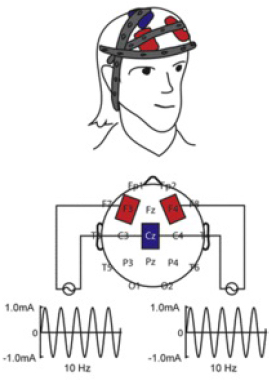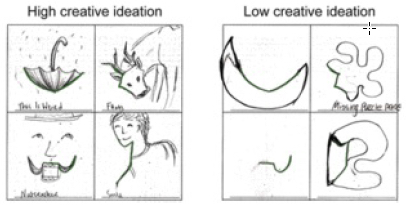Alpha-rhythm brain stimulation shown to boost creativity
April 17, 2015

Test of effects of frontal alpha-wave oscillations on creativity (credit: Caroline Lustenberger et al./Cortex)
By applying weak 10-Hz transcranial alternating current stimulation (tACS) to the scalp to alter the brain’s alpha-wave oscillations, University of North Carolina (UNC) School of Medicine researchers have increased creativity in healthy adults by an average of 7.4 percent.
Now they’re testing the same experimental protocol to alleviate symptoms in people with depression.
This research, published in the journal Cortex, showed that sending a current through electrodes attached to the scalp enhanced the brain’s natural alpha wave oscillations — prominent rhythmic patterns that can be seen on an electroencephalogram (EEG) device.
“This study is a proof-of-concept,” said senior author Flavio Frohlich, PhD, assistant professor of psychiatry, cell biology and physiology, biomedical engineering, and neurology. “We’ve provided the first evidence that specifically enhancing alpha oscillations is a causal trigger of a specific and complex behavior — in this case, creativity.
Potential treatment for depression
But their goal, he says, is to use tACS to help people with neurological and psychiatric illnesses. “For instance, there is strong evidence that people with depression have impaired alpha oscillations.”
Frohlich, who is also a member of the UNC Neuroscience Center, is now in collaboration with David Rubinow, MD, chair of the department of psychiatry, to use this particular kind of brain stimulation in two clinical trials for people with major depressive disorder and premenstrual dysphoric disorder (PMDD), a severe form of premenstrual syndrome. Participant enrollment is now underway for both trials.
“The fact that we’ve managed to enhance creativity in a frequency-specific way — in a carefully-done double-blinded placebo-controlled study — doesn’t mean that we can definitely treat people with depression,” Frohlich cautioned.
“But if people with depression are stuck in a thought pattern and fail to appropriately engage with reality, then we think it’s possible that enhancing alpha oscillations could be a meaningful, noninvasive, and inexpensive treatment paradigm for them, similar to how it enhanced creativity in healthy participants.”
Alpha rhythms
At the center of Frohlich’s research are alpha rhythms, which occur within the frequency range of 8 and 12 Hertz (Hz), discovered in 1929 by Hans Berger. Alpha oscillations occur most prominently when we close our eyes and shut out sensory stimuli.
“For a long time, people thought alpha waves represented the brain idling,” Frohlich said. “But over the past 20 years, we’ve developed much better insight. Our brains are not wasting energy, creating these patterns for nothing. When the brain is decoupled from the environment, it still does important things.
“When alpha oscillations are prominent, your sensory inputs might be offline as you daydream, meditate, or conjure ideas. But when something happens that requires action, your brain immediately redirects attention to what’s going on around you. You come fully online, and the alpha oscillations disappear. Other oscillations at higher frequencies, such as gamma oscillations, take over.”
The experiment

Sample results in creativity test. Left: with 10-Hz alpha oscillation stimulation. Right: with sham stimulation. (credit: Caroline Lustenberger et al./Cortex)
For the Cortex study, Frohlich’s team enrolled 20 healthy adults. Researchers placed electrodes on each side of each participant’s frontal scalp and a third electrode toward the back of the scalp. This way, the 10-Hz alpha oscillation stimulation for each side of the cortex would be in unison. This is a key difference in Frohlich’s method as compared to other brain stimulation techniques.
Each participant underwent two sessions. During one session, researchers used a 10-Hz sham stimulation for just five minutes. Participants felt a little tingle at the start of the five minutes. For the next 25 minutes, each participant continued to take the Torrance Test of Creative Thinking, a comprehensive and commonly used test of creativity.
In one task, each participant was shown a small fraction of an illustration — sometimes just a bent line on a piece of paper. Participants used the line to complete an illustration, and they wrote a title when they finished.
In the other session each participant underwent the same protocol, except they were stimulated at 10 Hertz for the entire 30 minutes while doing the Torrance test. The tingling sensation only occurred at the start of the stimulation, ensuring that each participant did not know which session was the control session.
Because rating creativity or scoring a test can involve subjectivity, Frohlich sent each participant’s work to the company that created the test. “We didn’t even tell the company what we were doing,” Frohlich said. “We just asked them to score the tests.”
Then Frohlich’s team compared each participant’s creativity score for each session. He found that during the 30-minute stimulation sessions, participants scored an average 7.4 percentage points higher than they did during the control sessions.
“That’s a pretty big difference when it comes to creativity,” Frohlich said. “Several participants showed incredible improvements in creativity. It was a very clear effect.”
Pattern-specific or artifact?
But what if the electrical stimulation merely caused a general electric effect on the brain, independent of the alpha oscillation? To find out, Frohlich’s team conducted the same experiments but used 40 Hertz of electrical current, which falls in the gamma frequency band typically associated with sensory processing — when the brain is computing what we see or touch or hear.
“Using 40 Hertz, we saw no effect on creativity,” Frohlich said. “The effect we saw was specific to the 10-hertz alpha oscillations. There’s no statistical trickery. You just have to look at each participant’s test to see these effects.”
Frohlich said he understood some people might want to capitalize on this sort of study to boost creativity in their everyday lives, but he cautioned against it. “We don’t know if there are long-term safety concerns,” he said. “We did a well-controlled, one-time study and found an acute effect.”
Instead, Frohlich is focused on treating people with depression and other mental conditions, such as schizophrenia, for which cognitive deficits during everyday life is a major problem.
“There are people that are cognitively impaired and need help, and sometimes there are no medications that help or the drugs have serious side effects,” Frohlich said. “Helping these populations of people is why we do this kind of research.”
Abstract of Functional role of frontal alpha oscillations in creativity
Creativity, the ability to produce innovative ideas, is a key higher-order cognitive function that is poorly understood. At the level of macroscopic cortical network dynamics, recent electroencephalography (EEG) data suggests that cortical oscillations in the alpha frequency band (8–12 Hz) are correlated with creative thinking. However, whether alpha oscillations play a fundamental role in creativity has remained unknown. Here we show that creativity is increased by enhancing alpha power using 10 Hz transcranial alternating current stimulation (10 Hz-tACS) of the frontal cortex. In a study of 20 healthy participants with a randomized, balanced cross-over design, we found a significant improvement of 7.4% in the Creativity Index measured by the Torrance Test of Creative Thinking (TTCT), a comprehensive and most frequently used assay of creative potential and strengths. In a second similar study with 20 subjects, 40 Hz-tACS was used in instead of 10 Hz-tACS to rule out a general “electrical stimulation” effect. No significant change in the Creativity Index was found for such frontal gamma stimulation. Our results suggest that alpha activity in frontal brain areas is selectively involved in creativity; this enhancement represents the first demonstration of specific neuronal dynamics that drive creativity and can be modulated by non-invasive brain stimulation. Our findings agree with the model that alpha recruitment increases with internal processing demands and is involved in inhibitory top-down control, which is an important requirement for creative ideation.